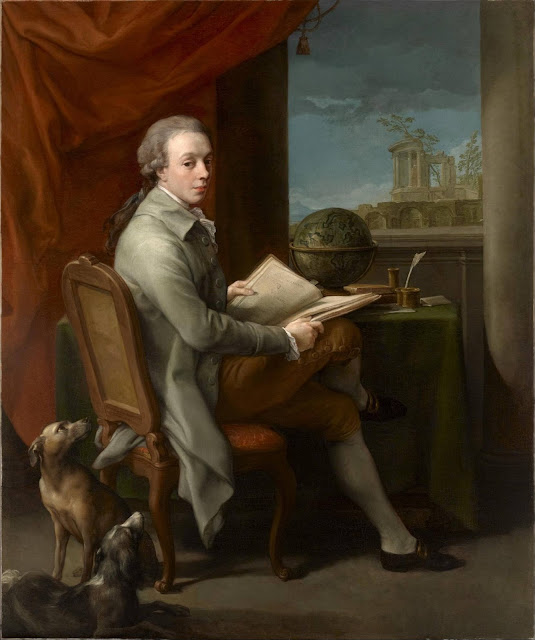 |
| Pompeo Batoni Portrait of William Fermor 1758 Museum of Fine Arts, Houston |
Pompeo Batoni (1708-1787) "was the most celebrated painter in Rome. For nearly fifty years he made portraits of Rome's visitors. He was equally gifted as a history painter, as well as being internationally known for his religious and mythological paintings." So say curators at the Victoria & Albert Museum, who go on to explain that Batoni's core clientele consisted of a steady fruitful stream of rich Englishmen on the Grand Tour. But Batoni was by no means running a portrait factory. The more of his work that is bought into view (and there will be two more posts after this one) the plainer it is that he never repeated himself. Distinct and rounded personalities emerge from each of these seemingly similar representations.
 |
| Pompeo Batoni Portrait of Thomas Tayleur, 1st Marquess of Headfort 1782 Museum of Fine Arts, Houston |
 |
| Pompeo Batoni Portrait of Philip Metcalfe mid-18th century National Portrait Gallery, London |
 |
| Pompeo Batoni Portrait of Frederick North, 2nd Earl of Guilford ca. 1752-56 National Portrait Gallery, London |
 |
| Pompeo Batoni Portrait of Thomas Kerrich mid-18th century private collection |
 |
| Pompeo Batoni Portrait of a gentleman 1762 National Gallery of Art (U.S.) |
 |
| Pompeo Batoni Portrait of Joseph Henry of Straffan ca. 1750-55 Walters Art Gallery |
 |
| Pompeo Batoni Portrait of Thomas Fortescu 1767 private collection |
 |
| Pompeo Batoni Portrait of Edward Howard 1766 Victoria & Albert Museum |
 |
| Pompeo Batoni Portrait of Emperor Joseph II with Grand Duke Pietro Leopoldo of Tuscany 1769 Kunsthistorisches Museum, Vienna |
 |
| Pompeo Batoni Portrait of John, 3rd Baron Monson of Burton 1774 private collection |
 |
| Pompeo Batoni Portrait of Francis Basset, 1st Baron Dunstanville 1778 Prado |
 |
| Pompeo Batoni Portrait of a young man ca. 1760-65 Metropolitan Museum of Art |
 |
| Pompeo Batoni Portrait of Sir Wyndham Knatchbull-Wyndham ca. 1758-59 Los Angeles County Museum of Art |
Full-length Batoni portraits tended to be rather enormous. This feature no doubt nurtured the already-healthy egos of those who paid. The canvas reproduced immediately above is about eight feet tall.